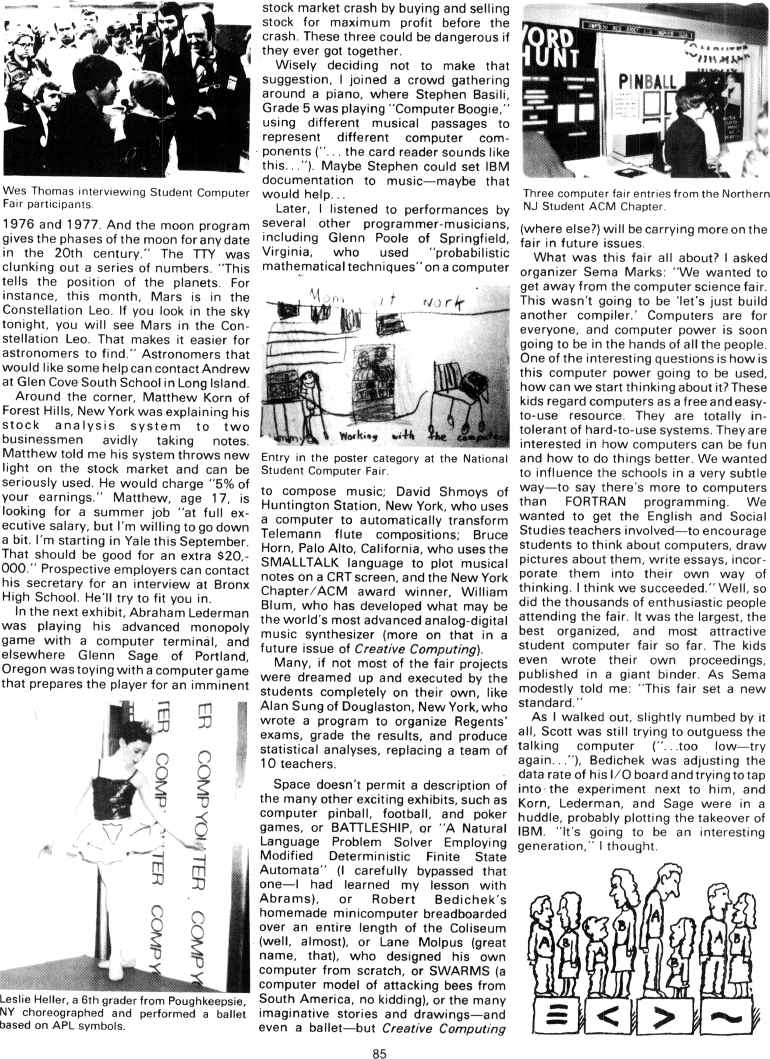The Best of Creative Computing Volume 2 (published 1977)
Computer Fair (Computer Astronomy Almanac, program for position of planets and phase of the moon, stock analysis system, computer music composition)

[Image]
Wes Thomas interviewing Student Computer
Fair participants.
1976 and 1977. And the moon program
gives the phases of the moon for any date
in the 20th century." The TTY was
clunking out a series of numbers. "This
tells the position of the planets. For
instance, this month, Mars is in the
Constellation Leo. If you look in the sky
tonight, you will see Mars in the Constellation
Leo. That makes it easier for
astronomers to find." Astronomers that
would like some help can contact Andrew
at Glen Cove South School in Long Island.
Around the corner, Matthew Korn of
Forest Hills, New York was explaining his
stock analysis system to two
businessmen avidly taking notes.
Matthew told me his system throws new
light on the stock market and can be
seriously used. He would charge "5% of
your earnings." Matthew, age 17, is
looking for a summer job "at full executive
salary, but l'm willing to go down
a bit. l'm starting in Yale this September.
That should be good for an extra $20,OOO."
Prospective employers can contact
his secretary for an interview at Bronx
High School. He'll try to fit you in.
ln the next exhibit, Abraham Lederman
was playing his advanced monopoly
game with a computer terminal, and
elsewhere Glenn Sage of Portland,
Oregon was toying with a computer game
that prepares the player for an imminent
[Image]
Leslie Heller, a 6th grader from Poughkeepsie,
NY choreographed and performed a ballet
based on APL symbols.
stock market crash by buying and selling
stock for maximum profit before the
crash. These three could be dangerous if
they ever got together.
Wisely deciding not to make that
suggestion, I joined a crowd gathering
around a piano, where Stephen Basili,
Grade 5 was playing "Computer Boogie,"
using different musical passages to
represent different computer components
("...the card reader sounds like
this..."). Maybe Stephen could set IBM
documentation to music-maybe that
would help...
Later, I listened to performances by
several other programmer-musicians,
including Glenn Poole of Springfield,
Virginia, who used "probabiIistic
mathematical techniques" on a computer
[Image]
Entry in the poster category at the National
Student Computer Fair.
to compose music; David Shmoys of
Huntington Station, New York, who uses
a computer to automatically transform
Telemann flute compositions; Bruce
Horn, Palo Alto, California, who uses the
SMALLTALK language to plot musical
notes on a CRT screen, and the New York
Chapter/ACM award winner, William
Blum, who has developed what may be
the world's most advanced analog-digital
music synthesizer (more on that in a
future issue of Creative Computing).
Many, if not most of the fair projects
were dreamed up and executed by the
students completely on their own, like
Alan Sung of Douglaston, New York, who
wrote a program to organize Regents'
exams, grade the results, and produce
statistical analyses, replacing a team of
10 teachers.
Space doesn't permit a description of
the many other exciting exhibits, such as
computer pinball, football, and poker
games, or BATTLESHIP, or "A Natural
Language Problem Solver Employing
Modified Deterministic Finite State
Automata" (I carefully bypassed that
one-I had learned my lesson with
Abrams), or Robert Bedichek's
homemade minicomputer breadboarded
over an entire length of the Coliseum
(well, almost), or Lane Molpus (great
name, that), who designed his own
computer from scratch, or SWARMS (a
computer model of attacking bees from
South America, no kidding), or the many
imaginative stories and drawings-and
even a ballet-but Creative Computing
[Image]
Three computer fair entries from the Northern
NJ Student ACM Chapter.
(where else?) will be carrying more on the
fair in future issues.
What was this fair all about? I asked
organizer Sema Marks: "We wanted to
get away from the computer science fair.
This wasn't going to be 'let's just build
another compiler.' Computers are for
everyone, and computer power is soon
going to be in the hands of all the people.
One of the interesting questions is how is
this computer power going to be used,
how can we start thinking about it? These
kids regard computers as a free and easy-to-use resource.
They are totally intolerant of hard-to-use systems. They are
interested in how computers can be fun
and how to do things better. We wanted
to influence the schools in a very subtle
way-to say there's more to computers
than FORTRAN programming. We
wanted to get the English and Social
Studies teachers involved-to encourage
students to think about computers, draw
pictures about them, write essays, incorporate
them into their own way of
thinking. I think we succeeded." Well, so
did the thousands of enthusiastic people
attending the fair. It was the largest, the
best organized, and most attractive
student computer fair so far. The kids
even wrote their own proceedings,
published in a giant binder. As Sema
modestly told me: "This fair set a new
standard."
As I walked out, slightly numbed by it
all, Scott was still trying to outguess the
talking computer ("...too low-try
again..."), Bedichek was adjusting the
data rate of his I/O board and trying to tap
into: the experiment next to him, and
Korn, Lederman, and Sage were in a
huddle, probably plotting the takeover of
IBM. "lt's going to be an interesting
generation," I thought.
[Image]


